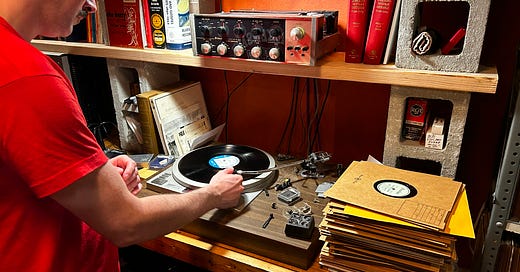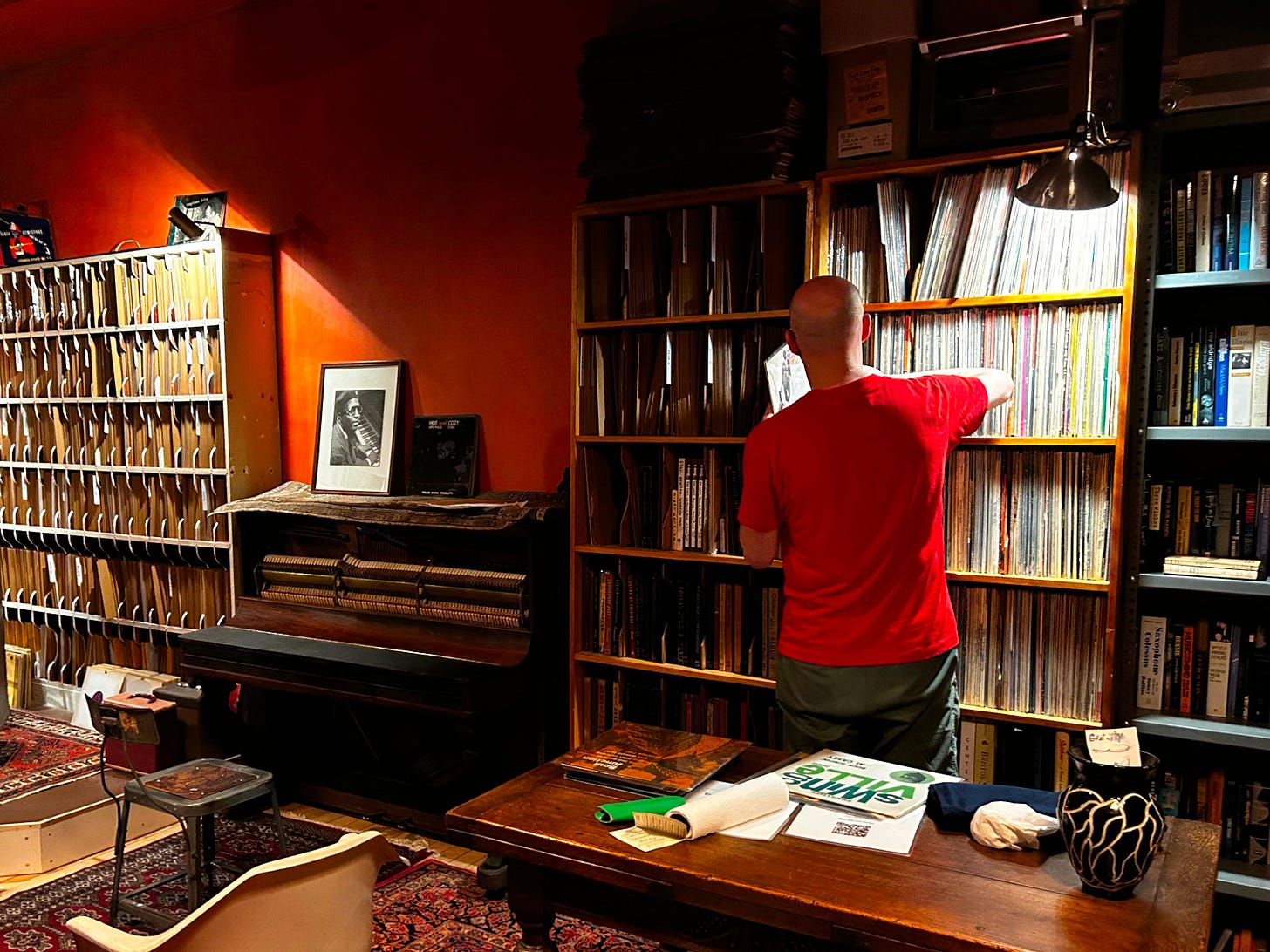78 RPM Shellac: A Jazz Listening Session in a Flatiron Loft
Inside the Hot Club of New York and its one-of-a-kind playback setup
Last Tuesday, July 1st, I stepped into a fourth-floor loft in Manhattan’s Flatiron District, inside a commercial building shared by artists and office tenants. The entrance was lined with boxes of 78s, immediate evidence that we were here for something special, a listening experience. The main space opened up into an area surrounded by shelves of records. A single RCA LC1A speaker stood elevated on a low stage at one end of the room. I had been invited by my friend Rich Capeless, someone I’ve gotten to know over the last year through listening meetups and a long-running text message thread on jazz records.
Earlier that day, I took the train from Fairfield, Connecticut into Grand Central, then hopped on the subway and began a record store loop at A1 Records. From there, I met up with Rich and friends and we continued digging at Stranded, Ergot, and Academy. It was a great warmup, a few hours of crate-digging and jazz record talk before heading over for the main event at the Hot Club of New York.
When we got to the Hot Club, Steve Guttenberg (yes, the Audiophiliac) was already in the room, chatting with Matt “Fat Cat” Rivera, who curates and hosts these sessions. Matt, for those who don’t know, studied under Phil Schaap at WKCR and has since dedicated himself to preserving and presenting 78-era jazz. The space he’s built here houses 20,000 78 rpm records and a mono playback chain that includes a Technics SP-15 turntable with an SME tonearm, McIntosh preamp, RCA SP-20 amp, and a single RCA LC1A with 16-inch coaxial speaker. Also Rich, who’s friends with Matt, brought along a vintage GE VR II mono cartridge to swap in during the session.

Not long after arriving, I spotted a UK Vogue 10-inch pressing of the Bud Powell Trio. I called it out immediately, it’s a record that has been on my want list. Recorded by Roost on January 10, 1947, it is one of the only Powell led sessions before he experienced electroconvulsive therapy (ECT). I mentioned it to Matt, who not only had this 10-inch LP, but the original Roost 78s too. So we queued them up for an A/B test and our listening session began.
We listened to the track “Somebody Loves Me” on both the UK Vogue 10-inch and the original Roost 78. The 78 had a slightly higher noise floor, something we heard across the 78 records that evening, however given it’s constant presence we agreed it was easy to tune out and didn’t detract from the listening experience really at all. That said, Bud Powell’s piano felt slightly more defined and present on the 78, and the drums and bass were buried on both the 10-inch LP and 78, which speaks more to the microphone placement and recording limitations than the medium.
Then came Bird. We listened to a Red Norvo side on Comet that featured Charlie Parker. I already knew the recording from a Dial LP reissue that I’ve played dozens of times, but here, on an original 78, on this system, I felt a physical response. I was waiting for Parker’s solo like it was an event and it spiked my heart rate. I’ve never had a record listening moment quite like that before. For me, it was the most thrilling experience of the session. Bird lives.
After more 78 listening we noted to Matt how buried the bass was, so Matt pulled out an Ellington and Jimmy Blanton duo 78 to show how good a double bass could sound in the format. I’ve heard and love the Pablo LP This One’s for Blanton with Ellington and Ray Brown, but never the original sides with Jimmy. Hearing them here was revelatory. Jimmy’s bass was stunning and equal to Ellington’s piano, the composition felt modern and edgy, and other than the early 40s recording limitations, could pass for something recorded today. I was surprised I hadn’t heard these before, but after this, I fully understand the reverence Jimmy Blanton commands. Incredible.
Then we shifted to 12-inch LPs, starting with two original pressings from the Miles Davis Quintet, “It Never Entered My Mind” from Workin’ and “Oleo” from Relaxin’. Miles’ muted horn felt like it was suspended in the room, absolutely stunning. And before I headed out, Rich played the opening track from Joe Henderson’s Page One (see image below). It also sounded excellent and hearing these sessions after the 78s made the progression from the early 1940s through the early 1960s all the more striking, a quantum leap in fidelity. But as much as I enjoyed these LPs, it was the 78s that made an impact and are what I’ve been thinking about since.
The vibe throughout the listening session was electric. We were all talking, trading insights, yelling out the names of the soloists, pulling records, discussing components, asking to hear this or that. It was incredibly fun. I actually had to stop myself from speaking too often (similar to a Jazz Bums livestream). Rich chimed in with gear details that helped me understand the playback chain better, something he talked about on the latest episode of Record Collector Confessions. Highly recommend checking that out.
I’m so happy that the Hot Club of New York exists, and frankly, a little shocked that it does. It’s a treasure trove of incredible music, and Matt is a great steward of this collection and a thoughtful guide through it. Every aspect of the evening, from the quality of the playback to the curation of the music to the tone of the conversation, was an invitation to discover the genius of early recorded jazz. What a remarkable project this is. It speaks not only to the importance of preserving this music, but also to the value of experiencing it together, with others. I encourage everyone to visit and hear for themselves what makes this space so special.
Sources
Hot Club of New York – About the Hot Club. https://www.hotclubny.com/about
Steinman, Michael. “Apostle of Shellac: Matthew ‘Fat Cat’ Rivera.” The Syncopated Times, Jan. 12, 2021.
https://syncopatedtimes.com/apostle-of-shellac-matthew-fat-cat-riveraNational Jazz Museum in Harlem. “Matthew ‘Fat Cat’ Rivera Bio.”
https://www.jmih.org/people/matthew-fat-cat-riveraDaily Hampshire Gazette. “Spinning the classics: Young jazz archivist Matthew Rivera will play vintage 78rpm records in Florence.” July 6, 2023.
https://www.gazettenet.com/matthew-rivera-plays-jazz-records-at-b2g-51427193





Good article although I'm confused about this being on Tuesday July 1 … aren't the listen sessions typically on Monday? Would also love to know the next year when July 1 falls on a Tuesday.
Reading your comments on the buried bass & drums on the Bud Powell side reminded me of a Chicago sextet of the ‘80s that included Barrett Deems on drums and bassist Truck Parham.
Wikipedia notes that Deems was in Louis Armstrong’s band when High Society was filmed and even gets some short solos in the film. Armstrong is widely considered to have the best sense of time for, well, the 20th century. Deems was with him for several years.
Parham had a lengthy career with some of the great swing era leaders. (See Wikipedia) when I